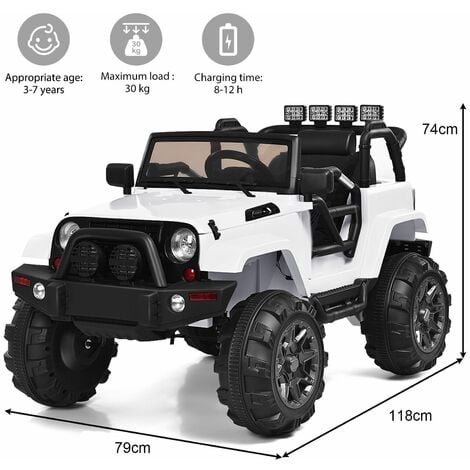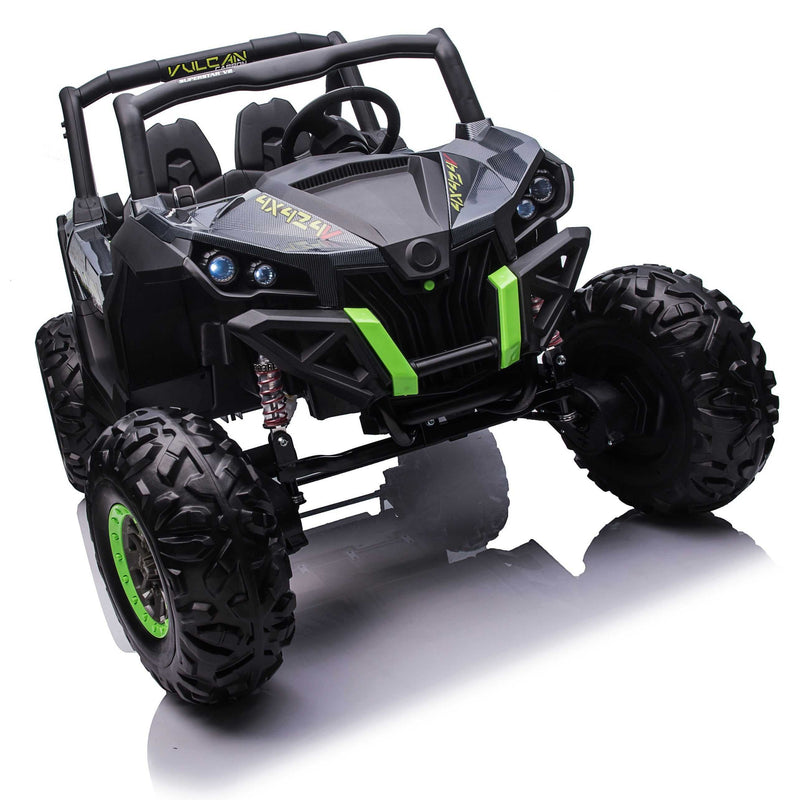Recommended Tips To Selecting Remote Control Childrens Cars
Recommended Tips To Selecting Remote Control Childrens Cars
Blog Article
What's The Battery Life Of An Electric Ride-On Car For Kids?
It is crucial to know the life span of your battery for the electric ride-on car for kids and how long it takes to charge. This will ensure you get uninterrupted playtime. What you need to understand - Battery Type
The majority of electric vehicles are rechargeable and use either lithium-ion or led-acid batteries. Lead-acid batteries take longer to charge and have a less battery life.
Capacity of Battery
The battery capacity is expressed in ampere hours (Ah) and Watt hours (Wh). This is how long the ride-on will last on one charge. Batteries with higher capacity provide longer playtime between recharges.
Run Time -
The run time is the maximum amount of continuous operation that an electric ride on car can run on one charge. This can vary depending on factors such as the capacity of the battery, motor power, terrain, as well as the weight of the rider.
The typical run time for electric ride-on vehicles is between 30 minutes to two hours. However, batteries with large capacity could have longer runtimes.
Charge Time
The charging time is the length of time required for batteries to be fully recharged after it has been depleted. The time to charge is based on the charger specification capacity, battery capacity, and the charging method.
Charge times range between 8 to 12 hours for a complete charge for electric rides-on automobiles. Certain models, specifically those that use lithium-ion batteries might have faster charging times.
To ensure safety and a long-lasting battery life, it's important to recharge the battery in accordance with the specifications of the manufacturer. Battery performance and longevity could be impacted by overcharging or undercharging.
Method of Charging
Electric ride-on cars usually include a charger which plugs into a household outlet. Some models feature fast charging features, or come with a charger that changes its rate of charging based on the state of the battery.
Verify whether the charging port on the ride-on cars are compatible to avoid damage to either the battery or the electrical components.
Batteries for Other Use -
Some electric cars permit the purchase of extra or extra batteries. This could extend playing time. The availability of extra batteries allows you to change out battery that is depleted to fully charged ones, which reduces interruptions between play sessions.
Knowing the battery's charge time of a kid's ride-on car will help ensure that you and your child can enjoy uninterrupted and fun playtime and exciting adventures. The battery's performance and longevity can be improved by regularly charging the batteries and following correct charging procedures. Follow the most popular Mercedes ride on car for blog recommendations including toy and car, kiddies cars, kidscars, two seater childrens electric cars, toy the car, toy in car, childs car toy, toy in car, two seater electric cars, electric toy car and more. . 
What Kind Of Maintenance And Assembly Requirements Are There For Children's Ride On Cars?
It is normal for children ride-on cars to require assembly along with ongoing maintenance, in order to maximize performance and safety. Here are the most common assembly and maintenance requirements for kid's ride-on cars - Assembly -
The majority of ride-on vehicles are assembled and require some assembly on arrival. Attaching the wheels, steering wheel seats, and other components to the ride-on car as per the directions of the manufacturer is the most popular method.
Follow the assembly guidelines carefully, ensuring that the components are properly attached and properly aligned. For final assembly, you will need the tools and accessories provided.
Cleaning -
The ride-on vehicles must be cleaned regularly to ensure that they appear good and perform properly. Make use of the soft, dampened cloth or sponge with mild soap and warm water to clean the exterior of your.
Pay attention to the areas that are susceptible to accumulation like undercarriage, tires and wheels. Use a brush or brush to remove grime from hard-to reach places.
Avoid using harsh chemical cleaners, abrasive chemicals, or high-pressure water sprays as these may cause damage to the paint or electronic components of the ride-on car.
Battery Care
If the ride-on vehicle is powered by a rechargeable battery proper battery care is essential for maintaining performance and extending the life of the battery. Follow these guidelines for maintaining your battery -
Charge the battery fully both prior to use and every time to extend the runtime.
The battery is not fully charged and keeping it in charge for prolonged durations can cause damage to the battery and reduce its lifespan.
When not in usage when not in use, store the ride on car and battery away from direct sunshine or extreme temperatures.
If you have to you need to clean the terminals, use a wire brush or terminal cleaner if they are corroded.
If the battery is no longer charging or shows signs or damage, replace it.
Tire Maintenance -
Examine the tires frequently for signs of damage, wear, or loss of air pressure. Inflate the tires to the recommended pressure using the bicycle pump or an air compressor if required.
Check the tread pattern for any debris or other foreign objects that may cause punctures or flats. Replace damaged tires and remove any obstructions.
Lubricate your wheels and axles to ensure smooth rotation.
Occasional Repairs and Replacements
Even with regular maintenance, ride-on cars may require occasional repairs or part replacements because of wear and tear or accidental damage.
Pay attention to indicators of malfunction and degradation such as unusual noises, loss of power or unusual behavior. Contact customer service or refer to the instructions from the manufacturer to assist in troubleshooting.
To avoid further damage, replace damaged or worn-out parts as soon as possible to ensure the safety of your equipment and its functionality.
By adhering to these assembly and maintenance guidelines by following these guidelines, you can keep your child's ride-on vehicle in great condition and enjoy hours of fun and safe playing time for your child. Take a look at the most popular JCB ride on digger for more tips including electric rideons, car electric ride on, ride on car, two seater childrens electric cars, two seater electric cars, car for toy, ride electric car, race car toy, riding digger, car toy car toy and more. . 
What Are The Factors To Be Thinking About Before Purchasing An Electric Kids Vehicle? What Are The Pros?
Before you purchase an electronic kids car There are many things to think about to make sure that you select the best model for your child's needs and needs. Here are some important considerations as well as information about the sizes, prices pro and cons The age and size of the Child -
Be aware of the age and size of your child before deciding on an electric kids' car. Models that are compact and light may be appropriate for smaller and younger children, whereas older and larger children might need cars with ample space.
The weight and size of the Car Size and Weight of the Car
Models for electric cars for kids are available in various sizes. From tiny to large-scale replicas, they are readily available. You should consider the weight and size of the car in relation to the child's size, strength and age. Additionally, you have be aware of the available space to store the car and play.
Price range
The cost of electric children's cars vary widely based on factors like size, features, brand, and build quality. Prices of micro-sized models range between $50-200 in comparison to larger-scale replicas can range from $600 to $800.
What are the pros and cons?
Pros -
Children's electric cars offer hours of entertainment, imaginative play, and the chance to drive their own vehicle.
Motor Skill Development. Operating an electric car helps children to develop coordination skills, spatial awareness and fine motor skills.
Outdoor Play - Electric vehicles promote outdoor play and activity. This promotes exercise and exploration.
Realistic Features- Many electronic children's cars come with realistic features, including functioning headlights and horns. They also work with MP3 players, which improves the overall experience.
Cons
Cost - Electric children's cars, particularly licensed replicas of brands, can be costly.
Battery Life The power in electric cars is provided by rechargeable batteries, which are able to run for a limited time and require frequent charging.
Safety Issues Electric cars are prone to safety hazards including collisions, falls, or traps. This is especially true if the car is not used with care and adult supervision.
Maintenance and Assembly - Some electric vehicles require assembly at the time of arrival. They may also require regular maintenance, like cleaning, battery treatment, and repairs or replacements of parts.
Features and Accessories
Consider the features and accessories included in the electric kids' car like functioning headlights, horn noises, parental remote control, seat belts, and storage compartments. Pick a car with features and accessories that work with your child's preferences.
The final verdict on the top electric vehicles for children will depend on factors like their age (or size) as well as their interests and financial budget. Check out reviews, compare models and consider the pros and cons prior to making your final choice. Have a look at the most popular JCB ride on toys kidscars.co.uk advice for website info including childrens electric cars, ride of car, remote control childrens car, a toy car, childs car toy, toy cars toy car, toy and car, toy ride, ride on toy, ride of car and more. .